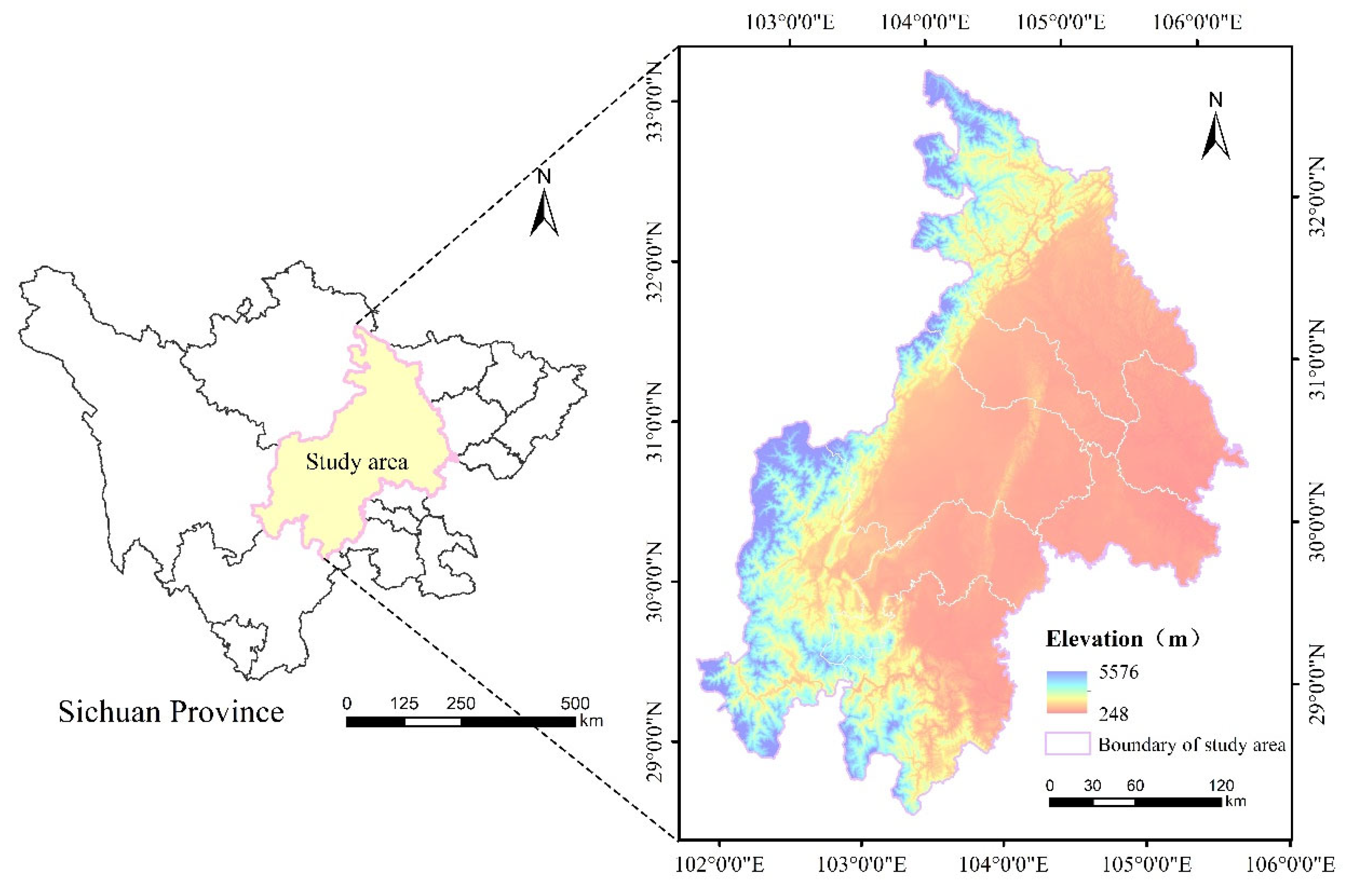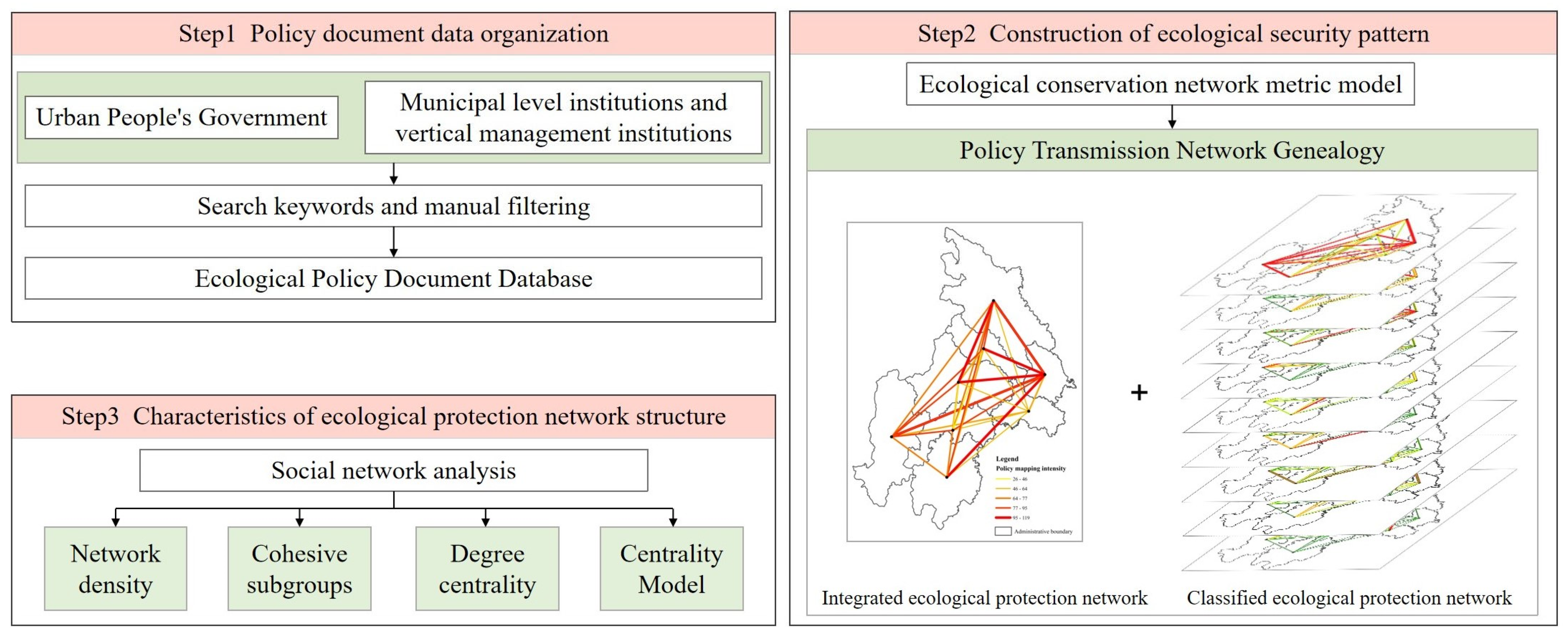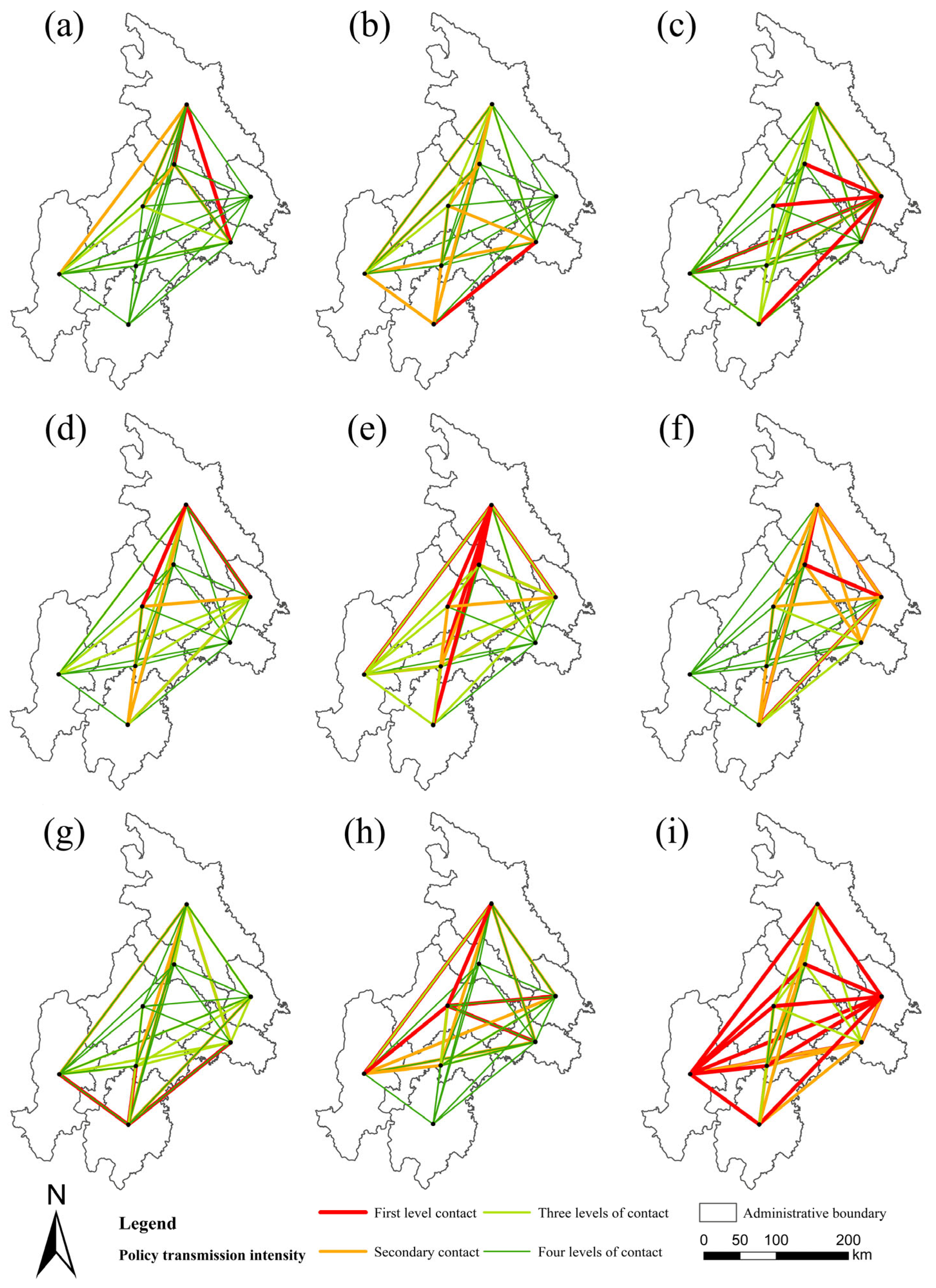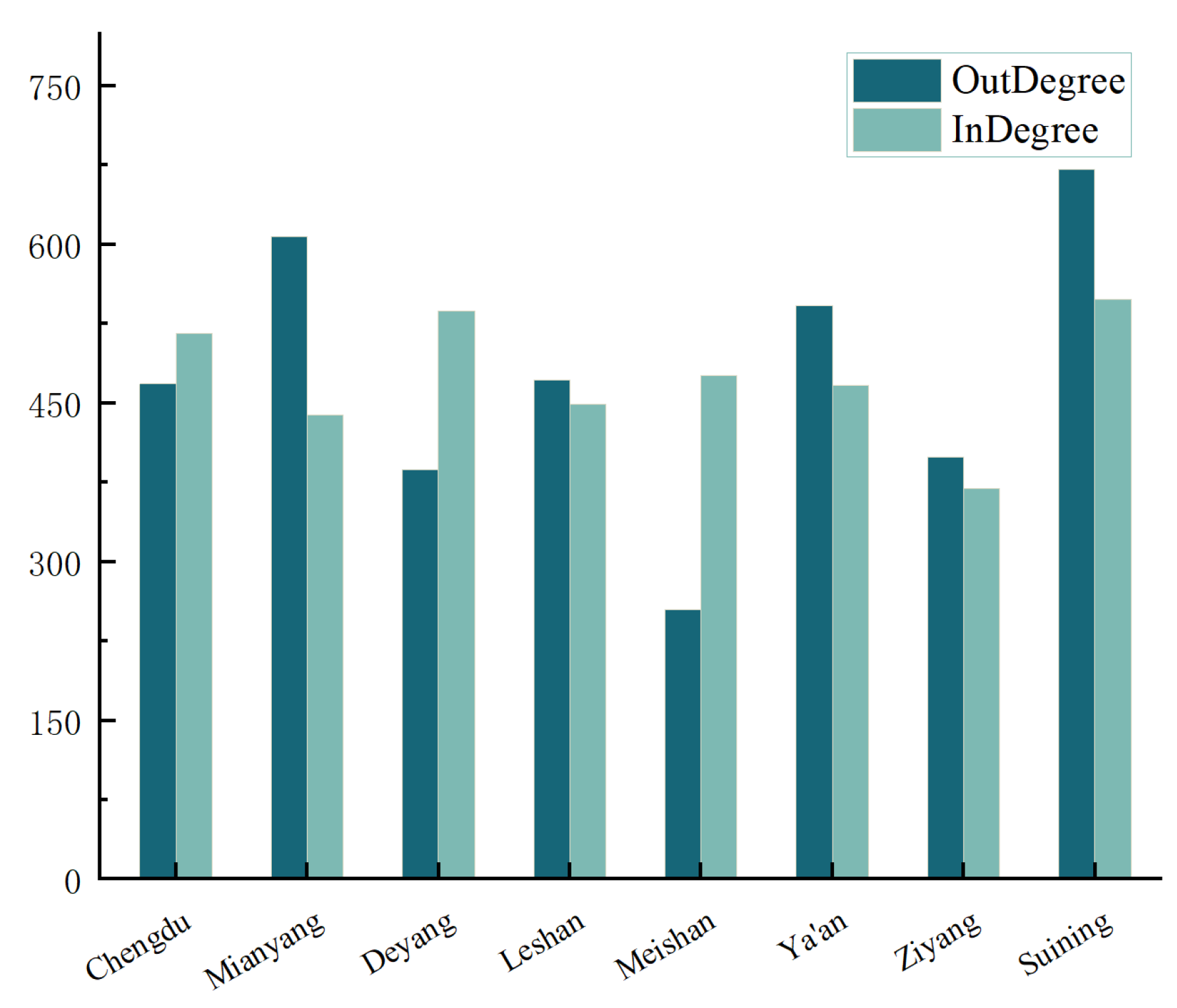An Analysis of Policy Transmission Flow in the Chengdu Plain Urban Agglomeration in Southwest China: Towards Building an Ecological Protection Network
Abstract
1. Introduction
2. Literature Review
3. Data and Methods
3.1. Study Area and Data Sources
3.1.1. Study Area
3.1.2. Data Sources
3.2. Methodology
3.2.1. Policy Transmission Flow Model
3.2.2. Social Network Analysis
- (1)
- Network density: Network density is used to reflect the level of network completeness in a region and the degree of spatial interaction among individual nodes within the network [44]. A higher network density indicates a stronger connection among network members and a more complete urban network. The calculation formula is as follows:where is the network density; is the city node; and represents the number of policy linkages between city and city .
- (2)
- Cohesive subgroups: Cohesive subgroups are a descriptive study of social structures that can reveal the actual or potential relationships or substructures among actors in a social network [45]. When there are close connections among cities within an urban cluster, a secondary cohesive subgroup can form. The presence of cohesive subgroups in a network indicates tight information exchange and transmission among cities within the subgroup.
- (3)
- Degree centrality: Network centrality can be measured in three forms: degree centrality, betweenness centrality, and closeness centrality [46]. These measures reflect the status and influence of city nodes within the network. Degree centrality refers to the comprehensive connectivity of a node in the network. If a node is connected to multiple nodes, it has a higher degree centrality, which effectively represents the city’s communicative capacity in the region [47]. The calculation formula is as follows:where is the out-degree and in-degree indicators of point-degree centrality; is the spatial association strength between cities and .
- (4)
- Centrality model: The centrality model of core–periphery structure is capable of measuring the centrality of cities, thereby assessing their level of power within the network. Core cities are situated at the top of the hierarchy, exerting dominant control over the flow of regional resources and playing a leading role in regional development [48]. Periphery cities, on the other hand, are located at the lower end of the hierarchy, possessing the resource elements that core cities require and engaging in resource exchange with them [49].
4. Results
4.1. Analysis of Ecological Protection Network Characteristics
4.1.1. Analysis of the Characteristics of the Integrated Ecological Protection Network
4.1.2. Analysis of Categorized Ecological Protection Network Characteristics
4.2. Ecological Protection Network Point-Degree Centrality Analysis
4.2.1. Point-Degree Centrality Analysis of the Integrated Ecological Protection Network
4.2.2. Point-Degree Centrality Analysis of Classified Ecological Protection Networks
4.3. Analysis of Cohesive Subgroups
4.4. Core–Periphery Structure Analysis
5. Discussion and Conclusions
- Strengthen the construction of the ecological protection network and enhance regional cooperative governance capabilities. Governments and relevant institutions should enhance the formulation and implementation of ecological protection policies, ensuring a smooth transmission and execution of policies between cities, promoting resource sharing and information exchange among cities, thereby improving the overall level of regional ecological protection.
- Improve the execution and effectiveness of ecological protection policies. Local governments should strengthen their execution capabilities, clearly define responsibilities, and improve the efficiency and effectiveness of policy implementation.
- Promote diversified cooperation and establish cross-regional ecological protection coordination mechanisms. Actively promote cooperation between cities, build cross-regional ecological protection coordination mechanisms, and enhance coordination and cooperation among cities in ecological protection.
Author Contributions
Funding
Institutional Review Board Statement
Informed Consent Statement
Data Availability Statement
Conflicts of Interest
References
- Guo, M.; Cong, X.; Zheng, H.; Zhang, M.J.; Wang, L.J.; Gong, J.W.; Ma, S. Integrating the ordered weighted averaging method to establish an ecological security pattern for the Jianghuai ecological economic zone in China: Synergistic intraregional development. Ecol. Indic. 2022, 135, 108543. [Google Scholar] [CrossRef]
- Yu, H.; Huang, J.; Ji, C.; Li, Z.A. Construction of a landscape ecological network for a large-scale energy and chemical industrial base: A case study of Ningdong, China. Land 2021, 10, 344. [Google Scholar] [CrossRef]
- Fang, C.L. Progress and the future direction of research into urban agglomeration in China. Acta Geogr. Sin. 2014, 69, 1130–1144. [Google Scholar]
- Ran, Z.; Gao, S.; Zhang, B.; Guo, C.; Ouyang, X.; Gao, J. Non-linear effects of multi-dimensional urbanization on ecosystem services in mega-urban agglomerations and its threshold identification. Ecol. Indic. 2023, 154, 110846. [Google Scholar] [CrossRef]
- Feng, Y.W.; Zhen, J.H.; Ma, C.Y. Research on Spatial Optimization of Urban Ecological Security Pattern in Arid Area—A Case Study of Hohhot City, Inner Mongolia. Res. Soil Water Conserv. 2020, 27, 336–341. [Google Scholar]
- Zeng, X.; Ma, Y.; Ren, J.; He, B. Assessing the network characteristics and structural effects of eco-efficiency: A case study in the urban agglomerations in the middle reaches of Yangtze River, China. Ecol. Indic. 2023, 150, 110169. [Google Scholar] [CrossRef]
- Castells, M. The Informational City: Information Technology, Economic Restructuring, and the Urban-Regional Process; Blackwell: Oxford, UK, 1989. [Google Scholar]
- Townsend, A.M. Network cities and the global structure of the Internet. Am. Behav. Sci. 2001, 44, 1697–1716. [Google Scholar] [CrossRef]
- Shen, L.Z.; Gu, C.L. Integration of Regional Space of Flows and Construction of Global Urban Network. Sci. Geogr. Sin. 2009, 29, 787–793. [Google Scholar]
- Wang, Y.; Niu, X.Y.; Song, X.D. Research Progress on Regional Spatial Structure from the Perspective of “Flow Space”. Int. Urban Plan. 2017, 32, 27–33. [Google Scholar] [CrossRef][Green Version]
- Li, Y.; Li, T.; Qiu, M.L.; Li, J.Y.; Cao, X.S. The Impact of Intercity Interaction on Urban Space Growth in the Guanzhong Plain Urban Agglomeration Based on Traffic Flows. Hum. Geogr. 2023, 38, 147–157. [Google Scholar]
- Liang, L.; Zhao, Y.B.; Wu, X.J. Research on the Temporal and Spatial Characteristics of Beijing-Tianjin-Hebei City Network from the Perspective of Population Flow: A Comparison Before and After the Establishment of Xiong’an New Area. Econ. Manag. 2019, 33, 1–8. [Google Scholar]
- Wei, G.E.; Sun, P.J.; Zhang, Z.K. Comprehensive Comparative Study on the Core System of Metropolitan Areas: A Case Study of the Three Metropolitan Areas in the Middle Reaches of the Yangtze River. Resour. Environ. Yangtze Basin 2021, 30, 11. [Google Scholar]
- Castells, M. Globalisation, networking, urbanisation: Reflections on the spatial dynamics of the information age. Urban Stud. 2010, 47, 2737–2745. [Google Scholar] [CrossRef]
- Vanli, T.; Akan, T. Mapping synergies and trade-offs between smart city dimensions: A network analysis. Cities 2023, 142, 104527. [Google Scholar] [CrossRef]
- Wang, N.N.; Chen, R.; Zhao, Y. Internet Information Space Network Analysis Based on Information Flow. Geogr. Res. 2016, 35, 137–147. [Google Scholar]
- Wu, X.; Wang, L.J.; Ning, Y.X.; He, Y. From Social Network to Geographic Network: An Analysis of Sina Weibo Users in Colleges and Universities in Nanjing. Econ. Geogr. 2020, 40, 83–95. [Google Scholar]
- An, D.; Hu, Y.J.; Wan, Y. Research on the Structural Characteristics of China’s Urban Information Flow Network Space: Based on Denoising Processing and Directed Network Analysis Methods. World Reg. Stud. 2024, 33, 134–148. [Google Scholar]
- Ma, S.; Long, Y. Functional urban area delineations of cities on the Chinese mainland using massive Didi ride-hailing records. Cities 2020, 97, 102532. [Google Scholar] [CrossRef]
- Ma, W.; Fang, Z.; Zhang, X. Comparative analysis of structural characteristics of China’s 18 typical urban agglomerations based on flows of various elements. Ecol. Model. 2023, 479, 110308. [Google Scholar] [CrossRef]
- Wei, X.; Xi, G.L.; Zhen, F. Study on the Coupling Relationship Between Commercial System and Actual Service Population Mobility. Econ. Geogr. 2022, 42, 10. [Google Scholar]
- Mashizi, A.K.; Sharafatmandrad, M. Dry forests conservation: A comprehensive approach linking ecosystem services to ecological drivers and sustainable management. Glob. Ecol. Conserv. 2023, 47, e02652. [Google Scholar]
- Xiao, J.; Song, F.; Su, F.; Wei, C. Exploring the interaction mechanism of natural conditions and human activities on wetland ecosystem services value. J. Clean. Prod. 2023, 426, 139161. [Google Scholar] [CrossRef]
- Mekuria, W.; Gedle, A.; Tesfaye, Y.; Phimister, E. Implications of changes in land use for ecosystem service values of two highly eroded watersheds in Lake Abaya Chamo sub-basin, Ethiopia. Ecosyst. Serv. 2023, 64, 101564. [Google Scholar] [CrossRef]
- Zhang, Y.; Hu, X.; Wei, B.; Zhang, X.; Tang, L.; Chen, C.; Wang, Y.; Yang, X. Spatiotemporal exploration of ecosystem service value, landscape ecological risk, and their interactive relationship in Hunan Province, Central-South China, over the past 30 years. Ecol. Indic. 2023, 156, 111066. [Google Scholar] [CrossRef]
- Zhai, Y.; Li, W.; Shi, S.; Gao, Y.; Chen, Y.; Ding, Y. Spatio-temporal dynamics of ecosystem service values in China’s Northeast Tiger-Leopard National Park from 2005 to 2020: Evidence from environmental factors and land use/land cover changes. Ecol. Indic. 2023, 155, 110734. [Google Scholar] [CrossRef]
- Richter, F.; Jan, P.; El Benni, N.; Lüscher, A.; Buchmann, N.; Klaus, V.H. A guide to assess and value ecosystem services of grasslands. Ecosyst. Serv. 2021, 52, 101376. [Google Scholar] [CrossRef]
- Xu, Y.; Xie, Y.; Wu, X.; Xie, Y.; Zhang, T.; Zou, Z.; Zhang, R.; Zhang, Z. Evaluating temporal-spatial variations of wetland ecosystem service value in China during 1990–2020 from the donor side based on cosmic exergy. J. Clean. Prod. 2023, 414, 137485. [Google Scholar] [CrossRef]
- Nesshöver, C.; Assmuth, T.; Irvine, K.N.; Rusch, G.M.; Waylen, K.A.; Delbaere, B.; Wittmer, H. The science, policy and practice of nature-based solutions: An interdisciplinary perspective. Sci. Total Environ. 2017, 579, 1215–1227. [Google Scholar] [CrossRef]
- Fang, X.; Li, J.; Ma, Q.; Zhou, R.; Du, S. A quantitative review of nature-based solutions for urban sustainability (2016–2022): From science to implementation. Sci. Total Environ. 2024, 927, 172219. [Google Scholar] [CrossRef]
- Armah, M.; Bossman, A.; Amewu, G. Information flow between global financial market stress and African equity markets: An EEMD-based transfer entropy analysis. Heliyon 2023, 9, e13899. [Google Scholar] [CrossRef]
- Zhao, Z.; Chen, J.C.; Bai, Y.P.; Liu, Y.; Wang, J.Y.; Li, M.H. Combing and Evaluation of Ecological Grass Husbandry Policy in Inner Mongolia—Based on Method of Social Network Analysis. Resour. Dev. Mark. 2019, 4, 7. [Google Scholar]
- Xie, G.D.; Zhang, C.X.; Zhang, C.S.; Xiao, Y.; Lu, C.X. The value of ecosystem services in China. Resour. Sci. 2015, 37, 1740–1746. [Google Scholar]
- Chengdu Municipal Bureau of Ecological Environment. Notice on Delineating High Polluting Fuel Burning Ban Zones; Chengdu Municipal Bureau of Ecological Environment: Chengdu, China, 2015. [Google Scholar]
- Chengdu Municipal Bureau of Ecological Environment. Notice on Restricted Areas and Time Periods for High Pollution Vehicles; Chengdu Municipal Bureau of Ecological Environment: Chengdu, China, 2015. [Google Scholar]
- Chengdu Municipal Bureau of Ecological Environment. Implementation Plan for the Construction of Hazardous Waste Centralized Disposal Facilities in Mianyang City (2017–2022); Chengdu Municipal Bureau of Ecological Environment: Chengdu, China, 2017. [Google Scholar]
- Chengdu Municipal Bureau of Ecological Environment. Interim Measures for the Rapid Response Management of Environmental Quality “Measurement and Management Collaboration” in Mianyang City; Chengdu Municipal Bureau of Ecological Environment: Chengdu, China, 2017. [Google Scholar]
- Ziyang Municipal People’s Government Office. Administrative Interview Measures for Ecological Environment Protection in Ziyang City. 2022. Available online: http://gk.ziyang.gov.cn/policy/details.aspx?id=1179 (accessed on 3 December 2022).
- Ya’an Forestry Bureau. The 13th Five Year Plan for Forestry Development in Ya’an City. 2016. Available online: https://www.yaan.gov.cn/gongkai/show/20161031172458-755237-00-000.html (accessed on 3 December 2022).
- Ya’an Municipal People’s Government Office. Notice on Issuing the “14th Five Year Plan for Water Safety Guarantee in Ya’an City”. 2022. Available online: https://www.yaan.gov.cn/gongkai/show/9c64c6c6d8d15bf5c6c188a51bc16e95.html (accessed on 3 December 2022).
- Wang, Y.Z.; Wang, H.J.; Zhang, B.; Huang, X.X. Analysis on the Network Structure of Urban Agglomeration and Its Influencing Factors Based on the Perspective of Multi-dimensional Feature Flow: Taking Wuhan Urban Agglomeration as an Example. Econ. Geogr. 2021, 41, 68–76. [Google Scholar]
- Wang, Z.H.; Qiao, H.H.; Zhang, S.S.; Gao, Y. Evolution of spatial pattern of inbound tourism flows and enlightenment of high-quality development of metropolitan tourism: Acase stady of Shanghai. J. Nat. Resour. 2022, 37, 3167–3182. [Google Scholar] [CrossRef]
- Xu, C.; Li, J.; Chen, J.; Yang, Q. Air pollution in heterogenous Chinese cities: Complex network, novel driver and decoupling nexus. Ecol. Indic. 2023, 156, 111077. [Google Scholar] [CrossRef]
- Yao, Y.; Guo, Z.; Huang, X.; Ren, S.; Hu, Y.; Dong, A.; Guan, Q. Gauging urban resilience in the United States during the COVID-19 pandemic via social network analysis. Cities 2023, 138, 104361. [Google Scholar] [CrossRef]
- Sun, J.P.; Hou, L.G. Research on Characteristics of Network Structure of Chengdu—Chongqing Urban Agglomeration Based on Tencent Population Migration Data. Mod. Urban Res. 2020, 9, 78–85. [Google Scholar]
- Yuan, J.; Chen, K.; Li, W.; Ji, C.; Wang, Z.; Skibniewski, M.J. Social network analysis for social risks of construction projects in high-density urban areas in China. J. Clean. Prod. 2018, 198, 940–961. [Google Scholar] [CrossRef]
- Rachman, Z.A.; Maharani, W. The analysis and implementation of degree centrality in weighted graph in Social Network Analysis. In Proceedings of the 2013 International Conference of Information and Communication Technology (ICoICT), Bandung, Indonesia, 20–22 March 2013; IEEE: Piscataway, NJ, USA, 2013; pp. 72–76. [Google Scholar]
- Su, L.; Stepchenkova, S.; Dai, X. The core-periphery image of South Korea on the Chinese tourist market in the times of conflict over THAAD. J. Destin. Mark. Manag. 2020, 17, 100457. [Google Scholar] [CrossRef]
- Dominiak, J. Human and social capital in urban agglomeration and its changes in the core-peripheries pattern. The example of Poznań agglomeration. City Cult. Soc. 2020, 23, 100371. [Google Scholar] [CrossRef]
- Zheng, L.; Long, F.; Zhang, S. Comparison of the spaces of call and traffic flows: An empirical study of Qianzhong urban region, China. Cities 2020, 107, 102927. [Google Scholar] [CrossRef]
- Zheng, S.; Yang, S.; Ma, M.; Dong, J.; Han, B.; Wang, J. Linking cultural ecosystem service and urban ecological-space planning for a sustainable city: Case study of the core areas of Beijing under the context of urban relieving and renewal. Sustain. Cities Soc. 2023, 89, 104292. [Google Scholar] [CrossRef]
- Chen, H.; Yan, W.; Li, Z.; Wende, W.; Xiao, S. A framework for integrating ecosystem service provision and connectivity in ecological spatial networks: A case study of the Shanghai metropolitan area. Sustain. Cities Soc. 2024, 100, 105018. [Google Scholar] [CrossRef]
- Kongjian, Y. Landscape ecological security patterns in biological conservation. Acta Ecol. Sin. 1999, 19, 8–15. [Google Scholar]
- Kang, J.; Zhang, X.; Zhu, X.; Zhang, B. Ecological security pattern: A new idea for balancing regional development and ecological protection. A case study of the Jiaodong Peninsula, China. Glob. Ecol. Conserv. 2021, 26, e01472. [Google Scholar] [CrossRef]








| Serial Number | Policy Name | Time | First-Level Type | Secondary Type | File Source |
|---|---|---|---|---|---|
| 1 | Notice on Delineating High Polluting Fuel Burning Ban Zones | 14 January 2015 | Regulation service | Gas regulation | [34] |
| 2 | Notice on Restricted Areas and Time Periods for High Pollution Vehicles | 7 July 2015 | Regulation service | Gas regulation | [35] |
| 100 | Interim Measures for the Rapid Response Management of Environmental Quality “Measurement and Management Collaboration” in Mianyang City | 18 May 2017 | Comprehensive service | Comprehensive service | [36] |
| 101 | Implementation Plan for the Construction of Hazardous Waste Centralized Disposal Facilities in Mianyang City (2017–2022) | 4 December 2017 | Regulation service | Environment purification | [37] |
| 270 | Notice on Issuing the Administrative Interview Measures for Ecological Environment Protection in Ziyang City | 15 October 2022 | Comprehensive service | Comprehensive service | [38] |
| 350 | The 13th Five Year Plan for Forestry Development in Ya’an City | 31 October 2016 | Comprehensive service | Comprehensive service | [39] |
| 401 | Notice on Issuing the “14th Five Year Plan for Water Safety Guarantee in Ya’an City” | 12 February 2022 | Regulation service | Hydrological regulation | [40] |
| City | Chengdu | Deyang | Leshan | Meishan | Mianyang | Suining | Ya’an | Ziyang |
|---|---|---|---|---|---|---|---|---|
| Chengdu | 0 | 52 | 43 | 52 | 43 | 52 | 52 | 43 |
| Deyang | 41 | 0 | 41 | 49 | 39 | 49 | 49 | 41 |
| Leshan | 41 | 49 | 0 | 49 | 41 | 49 | 49 | 41 |
| Meishan | 23 | 26 | 23 | 0 | 22 | 26 | 26 | 23 |
| Mianyang | 39 | 49 | 39 | 49 | 0 | 49 | 49 | 39 |
| Suining | 69 | 85 | 69 | 85 | 67 | 0 | 85 | 69 |
| Ya’an | 64 | 73 | 64 | 74 | 61 | 73 | 0 | 64 |
| Ziyang | 42 | 49 | 42 | 49 | 42 | 49 | 49 | 0 |
| City | Chengdu | Deyang | Leshan | Meishan | Mianyang | Suining | Ya’an | Ziyang |
|---|---|---|---|---|---|---|---|---|
| Chengdu | 0 | 1 | 0 | 1 | 0 | 1 | 1 | 0 |
| Deyang | 0 | 0 | 0 | 1 | 0 | 1 | 1 | 0 |
| Leshan | 0 | 1 | 0 | 1 | 0 | 1 | 1 | 0 |
| Meishan | 0 | 0 | 0 | 0 | 0 | 0 | 0 | 0 |
| Mianyang | 0 | 1 | 0 | 1 | 0 | 1 | 1 | 0 |
| Suining | 1 | 1 | 1 | 1 | 1 | 0 | 1 | 1 |
| Ya’an | 1 | 1 | 1 | 1 | 1 | 1 | 0 | 1 |
| Ziyang | 0 | 1 | 0 | 1 | 0 | 1 | 1 | 0 |
| Type 1 | Types of Ecological Protection Networks | Network Density |
|---|---|---|
| Supply Service | Grain production | 21.43% |
| Water supply | 26.79% | |
| Regulation Service | Gas regulation | 35.71% |
| Climate regulation | 53.57% | |
| Environment purification | 35.71% | |
| Hydrological regulation | 39.29% | |
| Support Service | Soil erosion control | 37.50% |
| Cultural Service | Providing of aesthetic landscape | 32.14% |
| Comprehensive Service | Comprehensive service | 58.93% |
| Network Type | Core City | City on the Edge |
|---|---|---|
| Grain production | Cheng, De, Mian, Zi | Le, Sui, Ya, Mei |
| Water supply | Cheng, De, Le, Ya | Mei, Sui, Mian, Zi |
| Gas regulation | Cheng, De, Mian, Le, Sui | Mei, Ya, Zi |
| Climate regulation | Cheng, De, Le, Mei, Mian, Sui, Ya | Zi |
| Environment purification | Cheng, Sui, Le, Mian | Mei, De, Ya, Zi |
| Hydrological regulation | Mian, Mei, Le | De, Cheng, Sui, Ya, Zi |
| Soil erosion control | Cheng, Sui, Le | Mei, Mian, De, Ya, Zi |
| Providing of aesthetic landscape | Cheng, Mei, Ya, Mian | De, Sui, Le, Zi |
| Comprehensive service | Cheng, De, Ya, Sui | Mian, Mei, Le, Zi |
Disclaimer/Publisher’s Note: The statements, opinions and data contained in all publications are solely those of the individual author(s) and contributor(s) and not of MDPI and/or the editor(s). MDPI and/or the editor(s) disclaim responsibility for any injury to people or property resulting from any ideas, methods, instructions or products referred to in the content. |
© 2024 by the authors. Licensee MDPI, Basel, Switzerland. This article is an open access article distributed under the terms and conditions of the Creative Commons Attribution (CC BY) license (https://creativecommons.org/licenses/by/4.0/).
Share and Cite
Hou, L.; Deng, Y.; Wang, X.; Liu, T.; Xu, Y.; Wang, J. An Analysis of Policy Transmission Flow in the Chengdu Plain Urban Agglomeration in Southwest China: Towards Building an Ecological Protection Network. Sustainability 2024, 16, 5398. https://doi.org/10.3390/su16135398
Hou L, Deng Y, Wang X, Liu T, Xu Y, Wang J. An Analysis of Policy Transmission Flow in the Chengdu Plain Urban Agglomeration in Southwest China: Towards Building an Ecological Protection Network. Sustainability. 2024; 16(13):5398. https://doi.org/10.3390/su16135398
Chicago/Turabian StyleHou, Langong, Yingjia Deng, Xiaolan Wang, Tao Liu, Yuanhang Xu, and Jing Wang. 2024. "An Analysis of Policy Transmission Flow in the Chengdu Plain Urban Agglomeration in Southwest China: Towards Building an Ecological Protection Network" Sustainability 16, no. 13: 5398. https://doi.org/10.3390/su16135398
APA StyleHou, L., Deng, Y., Wang, X., Liu, T., Xu, Y., & Wang, J. (2024). An Analysis of Policy Transmission Flow in the Chengdu Plain Urban Agglomeration in Southwest China: Towards Building an Ecological Protection Network. Sustainability, 16(13), 5398. https://doi.org/10.3390/su16135398





